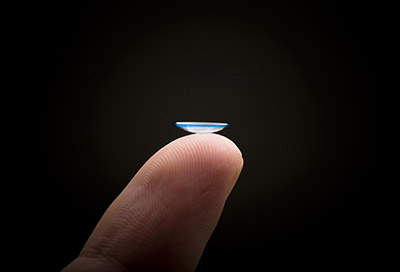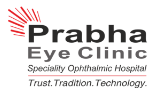Prabha Eye Clinic provides complete contact lens fitting and dispensing services.The Contact lens clinic fits cosmetic contact lenses that correct for nearsightedness, farsightedness. Contact lenses also have therapeutic uses, and contacts for a medical diagnosis are prescribed as well.
At Prabha Eye Clinic, the objective of any contact lens fitting is to provide good comfort, good vision, and maintain eye health.
Specialists:
- Dr. Arvind.K

More Information About Contact Lenses
Definition -
Uses-
- Myopia (nearsightedness)
- Hyperopia (farsightedness)
- Astigmatism (distorted vision)
- Presbyopia (need for bifocals)
Special tinted contacts can be used to change the color of the eyes to various degrees. Contact lenses are sometimes used therapeutically in eye diseases where an uneven cornea blurs vision, such as keratoconus or scarring. The health of the eyes should be of main concern. Contact lens should be used only when prescribed by the eye doctor.
Types of Contact Lenses
Rigid or “hard” contacts were the first lenses; they were developed in the 1960’s. They are made of a type of plastic called PMMA (polymethyl methacrylate), which is very durable, but does not allow oxygen in the air to directly reach the cornea. When the eye blinks, the lens moves, which allows the oxygen dissolved in the tears to reach the cornea. Rigid lenses are the least comfortable type of contacts and are not really used anymore. However, some people still prefer them for their durability and lower cost.
These lenses are also known as “RGPs.” They are newer rigid or “hard” lenses made of plastics combined with other materials, such as silicone and fluoropolymers, which allow oxygen in the air to pass directly through the lens. For this reason, they are called “gas permeable”.
These lenses are made of plastic materials that incorporate water. The water makes them soft and flexible, as well as allowing oxygen to reach the cornea. Extended wear contact lenses: made of material designed to last 2-4 weeks. Most of the people prefer soft contact lenses due to the flexibility.
- PMMA Lenses:
- Gas-Permeable Lenses:
- Soft Contact Lenses:
although generally more expensive, carry a lower infection risk. correct moderate astigmatism. They are available in both rigid and soft materials.
- Daily Disposable Lenses:
- Toric Contact Lenses:
Contacts should be removed at bedtime due to risk of infection and risk of contact lens intolerance.
What is the Cost?
What Are the Risks?
Daily-wear lenses should never be worn as extended-wear lenses. Misuse can lead to temporary and even permanent damage to the cornea. People who wear any type of lens overnight have a greater chance of developing infections of the cornea. These infections are often due to poor cleaning and lens care. Improper over wearing of contact lenses can result in intolerance, leading to the inability to wear contact lenses.
Rigid gas-permeable or disposable lenses may be good choices for someone with allergies.
Who should not Wear Contact Lenses?
Are Contacts for You?
- Individual needs and expectations.
- Patience and motivation during the initial adjustment period to contact lens wear.
- Adhering to contact lens guidelines for wear, disinfecting and cleaning.
- Diagnosis and treatment of conditions that may prevent contact lens wear.
How Do you Care for them?
- Contact lenses must be properly cleaned and disinfected when you remove them to kill germs and prevent infections.
- At the time you insert your contact lenses, you should thoroughly rinse the case with warm water and allow it to dry. All contact lens cases need frequent cleaning, including disposable lens cases.
- Do not put your lens in your mouth and then in your eye.
- Do not use homemade cleaning solutions, they have been linked to serious eye infections.
- Do not attempt to sterilize disposable lenses – throw them away.
- Do not mix different brands of solutions.
- Any eye drops, even nonprescription ones, can interact with all types of contact lenses. Use the brand of solution prescribed by our doctor or check with the doctor before changing brands.
Wear your Lenses properly
- Contact lenses must be properly cleaned and disinfected when you remove them to kill germs and prevent infections.
- At the time you insert your contact lenses, you should thoroughly rinse the case with warm water and allow it to dry. All contact lens cases need frequent cleaning, including disposable lens cases.
- Do not put your lens in your mouth and then in your eye.
- Do not use homemade cleaning solutions, they have been linked to serious eye infections.
- Do not attempt to sterilize disposable lenses – throw them away.
- Do not mix different brands of solutions.
- Any eye drops, even nonprescription ones, can interact with all types of contact lenses. Use the brand of solution prescribed by our doctor or check with the doctor before changing brands.
Call your Doctor when you Notice any of these Symptoms
- Your eye is painful,
- Your eye is red for more than two days,
- You have discharge from your eye,
- You have blurry vision,
- Your eye feels scratchy.






